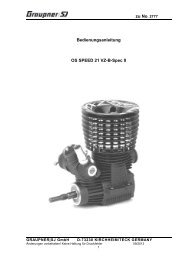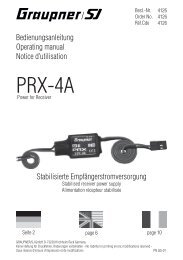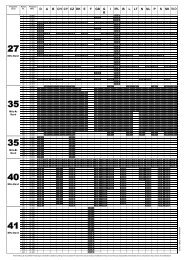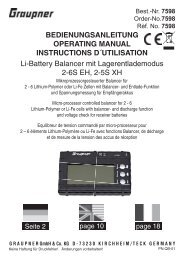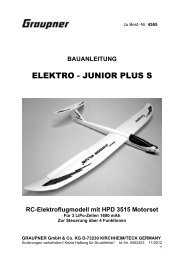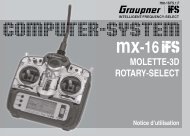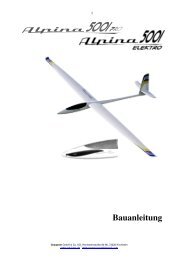Create successful ePaper yourself
Turn your PDF publications into a flip-book with our unique Google optimized e-Paper software.
mounting: connect two tension springs together and thread the piece of silicone hose<br />
on it as shown in Fig. 90; bag I.<br />
Connect the exhaust manifold to the silencer using Teflon exhaust hose (6861.28)<br />
and spring clips (6865). The exhaust gas exits the fuselage by means of a piece of<br />
silicone hose, Order No. 1567 (not included in the kit) attached to the silencer outlet<br />
pipe, and a generously dimensioned opening must be cut in the underside of the<br />
fuselage in the area of the silencer outlet to clear the hose.<br />
The cooling air openings in the engine cowl and bulkhead provide an adequate airflow<br />
over the engine and exhaust assembly while the model is flying; the air exits the<br />
model through the fuselage tail former.<br />
General<br />
Once you have carried out all the work described in these building instructions, the<br />
basic airframe of your model should be complete. As already mentioned in the<br />
introduction, these instructions do not cover every single stage of construction in<br />
detail, since the model requires considerable expertise and experience from the<br />
builder in terms of constructional (and piloting) skills. The more technically talented<br />
modeller will be able to construct the model and install the mechanical systems<br />
virtually by referring to the illustrations alone.<br />
We recommend that you install all the control system linkages and - in particular - the<br />
complete engine assembly, then remove all the parts again before you start painting<br />
or covering the model. If you wish to achieve as good a power : weight ratio as<br />
possible we recommend that you cover the wings and tail panels with iron-on film, and<br />
apply a painted finish to the GRP parts. These are high-quality mouldings, virtually<br />
devoid of faults and air bubbles. Be sure to use a type of paint designed for these<br />
materials. Once the model has been painted in the colour scheme of your choice, reinstall<br />
all the power system and RC system components carefully and conscientiously.<br />
Secure all metal-to-metal screwed joints using Loctite, Order No. 951, including all the<br />
control system pushrods (Figs. 92, 93). Check that the aluminium crimp sleeves are<br />
crimped sufficiently tightly on the control cables for the rudder and steerable tail wheel<br />
(Figs. 92, 98). All horns must be securely fixed using screws or glue as specified, and<br />
all loose cables secured with cable ties and the retainer plates supplied. This is<br />
especially important in the forward part of the fuselage where the exhaust system<br />
generates enormous heat, and cable insulation can melt upon contact. This also<br />
applies to the fueltank and petrol feed tubing.<br />
If the model is built according to the instructions and the recommended RC<br />
components are installed, then it should be possible to achieve the correct Centre of<br />
Gravity without adding more weight in the form of lead ballast. Our test models turned<br />
out slightly nose-heavy (i.e. on the docile side), fitted with a ZDZ 80 petrol engine and<br />
a 2000 mAh receiver battery in the front part of the fuselage (Figs. 99, 100), attached<br />
to the undercarriage brace with cable ties, and the ignition battery mounted on the RC<br />
installation plate (Fig. 100).<br />
To extend the servo leads we strongly advise you to use genuine <strong>Graupner</strong>/JR<br />
extension leads. If you have installed two servos in each wing panel, we recommend<br />
installing one Magic Box on each side, in order a) to couple the servos in a similar<br />
manner to a Y-lead, and b) to allow you set exactly identical servo end-points. You<br />
should now be able to assemble the model completely, tighten all screws and fixings,<br />
17





